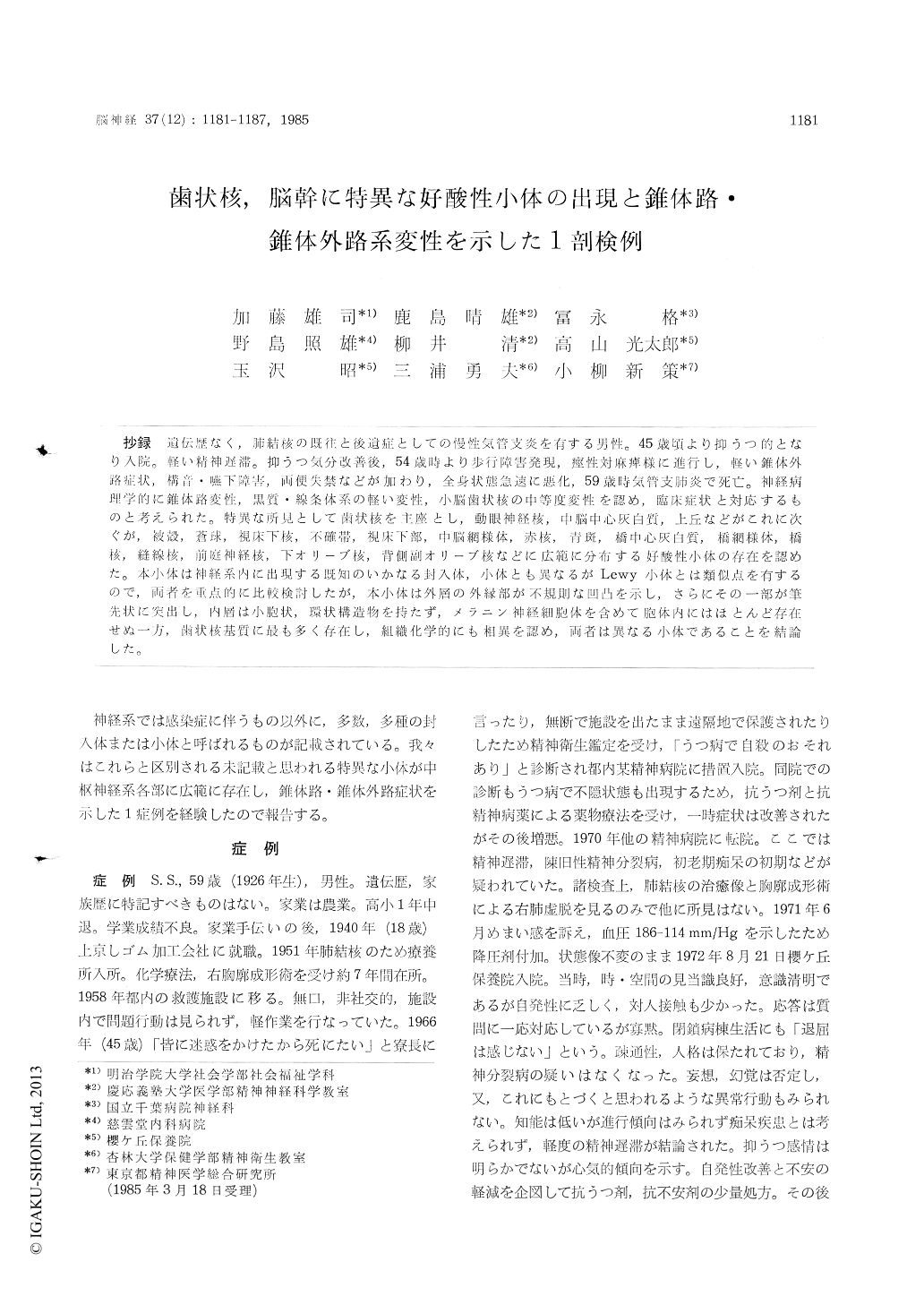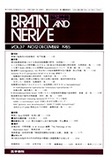Japanese
English
- 有料閲覧
- Abstract 文献概要
- 1ページ目 Look Inside
抄録 遺伝歴なく,肺結核の既往と後遺症としての慢性気管支炎を有する男性。45歳頃より抑うつ的となり入院。軽い精神遅滞。抑うつ気分改善後,54歳時より歩行障害発現,痙性対麻癖様に進行し,軽い錐体外路症状,構音・嚥下障害,両便失禁などが加わり,全身状態急速に悪化,59歳時気管支肺炎で死亡。神経病理学的に錐体路変性,黒質・線条体系の軽い変性,小脳歯状核の中等度変性を認め,臨床症状と対応するものと考えられた。特異な所見として歯状核を主座とし,動眼神経核,中脳中心灰白質,上丘などがこれに次ぐが,被殻,蒼球,視床下核,不確帯,視床下部,中脳網様体,赤核,青斑,橋中心灰白質,橋網様体,橋核,縫線核,前庭神経核,下オリーブ核,背側副オリーブ核などに広範に分布する好酸性小体の存在を認めた。本小体は神経系内に出現する既知のいかなる封入体,小体とも異なるがLewy小体とは類似点を有するので,両物を重点的に比較検討したが,本小体は外層の外縁部が不規則な凹凸を示し,さらにその一部が筆先状に突出し,内層は小胞状,環状構造物を持たず,メラニン神経細胞体を含めて胞体内にはほとんど存在せぬ一方,歯状核基質に最も多く存在し,組織化学的にも粗異を認め,両者は異なる小体であることを結論した。
Case S. S. 59 years of age, male. At the age of 25, he had admitted to sanatorium for 7 years be-cause of pulmonary tuberculosis. After his dischar-ge, at the age of 45, he had started complaining of depressive mood or the idea of suicide and admit-ted to a mental hospital. Psychiatric diagnosis was depression and slight mental retardation. Shortly after, his depressive mood was improved, but his hypochondriac attitude was unchanged. No ten-dency toward dementia was proven. At the age of 54, he became enable to walk. Neurologically, pyramidal and some sort of extrapyramidal signs, dysarthria, disturbance of swallowing, fecal and urinary incontinence became apparent. Laboratory data showed scarecely any abnormality. At the age of 59, he died of bronchopneumonia.
Neuropathologically, moderate degeneration of dentate nucleus, slight degeneration of pyramidal tract from medulla oblongata to spinal cord, stria-tum, substantia nigra were found. Neither senile plaques nor neurofibrillary changes could be seen throughout central nervous system.
The most important finding is the presence of peculiar acidophilic bodies. They are round or oval, 10~20μ in diameter and distributed in dentate nucleus, oculomotor nucleus, central grey of mid-brain, superior colliculus, putamen, pallidum, sub-thalamic nucleus, Zona incerta, hypothalamus, Lo-cus coeruleus, reticular formation of midbrain and pons, pontine nucleus, raphe nucleus, vestibular nucleus, inferior olive in order of number of the bodies. These bodies are scattered in so-called ground substance, and have no relations to any cell bodies or cell processes.
In this body two parts are discernible:
1) Central part : acidophilic, hyaline like, bril-liant red in Azan stain, PAS positive, Millon positive, Luxol Fast Blue positive, Alcian blue positive, and argyrophilic.
2) Peripheral part : slightly acidophilic, blue in Azan stain, SBB positive, and has radial arranged fibrillary structure.
Ultrastrurally, inner part consisted of fine gra-nular component with high electron density, but no vesicular or circular element was found. In outer part, radially oriented filaments of 100 A in diameter with high electron density were re-marked. These bodies have some resemblance with Lewy body. But these bodies are most numerous in dentate nucleus of cerebellum, Alcian-blue positive, and have no relations to any cell ele-ments. Many of these bodies have two parts, inner and outer layer, but some of them have four layers, and at some portion of the peripheral part have protrusion.
Ultrastructurally, no vesicular or circular com-ponents were found in inner part, filaments in outer part are more electron-dense and more solid than those of Lewy bodies.
We concluded this body as the new and never described type of so-called body or inclusion body in the nervous system.

Copyright © 1985, Igaku-Shoin Ltd. All rights reserved.


